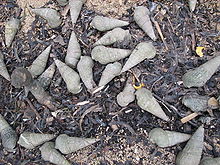Terebralia palustris
| Terebralia palustris | |
|---|---|
 |
|
| Terebralia palustris | |
 |
|
| Terebralia palustris | |
| Scientific classification | |
| Kingdom: | Animalia |
| Phylum: | Mollusca |
| Class: | Gastropoda |
| (unranked): | clade Caenogastropoda clade Sorbeoconcha |
| Superfamily: | Cerithioidea |
| Family: | Potamididae |
| Genus: | Terebralia |
| Species: | T. palustris |
| Binomial name | |
|
Terebralia palustris (Linnaeus, 1767) |
|
| Synonyms | |
|
|
Terebralia palustris, common name the giant mangrove whelk, is a species of brackish-water snail, a gastropod mollusk in the family Potamididae. This tropical species which inhabits mangrove environments of the Indo-West Pacific region, has the widest geographic distribution amongst the potamidids extending from eastern Africa to northern Australia. Terebralia palustris is the largest mangrove gastropod, with a maximum shell length of 190 mm recorded from Arnhem Land, Australia.
This species has the widest distribution range of any Terebralia species. Its Western Pacific distribution extends south from the Ryukyus to the Philippines and across Borneo, New Guinea and tropical Australia. Eastwards, T. palustris is found as far as Palau as well the New Hebrides and New Caledonia.
The Indian Ocean occurrence of Terebralia palustris includes mangrove habitats throughout Indonesia and regions of South East Asia including India and Ceylon. The species has also been reported from the Andaman Islands, Nicobar, the Maldives, Mauritius, the Seychelles, the Amirantes and Madagascar. Terebralia palustris also occurs along the tropical and subtropical East African coastline including Kenya, Tanzania and Mozambique. The southern global distribution limit for this species is along the eastern subtropical coastline of South Africa. The northward extension of the African distribution is as far as the Red Sea.
...
Wikipedia
